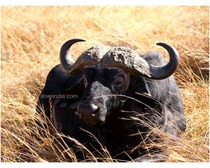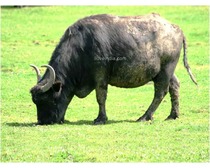An endangered species, the water buffalo is now confined to a few countries only. Explore the article to know more interesting facts and amazing information about water buffalos.
Facts About Water Buffalo
Water buffalo, or domestic Asian water buffalo, is believed to have originated in Asia, but has been introduced to Australia, Africa, Europe, Egypt and North America gradually. This endangered species has been domesticated by humans for thousands of years now, to pull machinery and carry heavy loads. Since they are endangered, they can be found in a small number of protected areas stretching across India, Nepal and Bhutan, and a wildlife reserve in Thailand. They are a source of various human needs, such as meat, horns, hides, milk and milk products (yoghurt, cheese, ghee, etc.), butterfat, power, leather, plowing and transporting people and crops. Buffalo milk contains the highest amount of fat amongst all the farm animals. Its dung is dried and used as a fertilizer and fuel. To know more interesting facts and amazing information about water buffalos, explore the article further.

Facts About Water Buffalo
Kingdom: Animalia
Phylum: Chordata
Class: Mammalia
Order: Artiodactyla
Family: Bovidae
Subfamily: Bovinae
Tribe: Bovini
Genus: Bubalus
Species: B. bubalis
Height: 6.6-9.8 ft
Weight: 1500-2650 lbs
Lifespan: 15-25 years
Diet: Grass and herbs.
Habitat: Grasslands, tropical and sub-tropical forests.
Age of Sexual Maturity: 2-3 years
Gestation Period: 9-11 months
Number of Offspring: One every second year
Interesting & Amazing Information On Water Buffalos
- Water buffalo is the largest member of the Bovine tribe that includes yak, bison, African buffalo, some species of wild cattle and others.
- The buffalo has been distributed across Bangladesh, Burma, Cambodia, India (Assam and Orissa), Nepal, North Thailand, Vietnam and Laos.
- The animal is domesticated in North Africa, South Europe, England, East Indonesia and east of South America.
- Around 95% of the world’s total water buffalo population is found in Asia, with India being the home of half of them.
- Most of the water buffalo’s day is spent being submerged in the muddy waters of Asia’s tropical and sub-tropical forests.
- Water buffalo races, known as Kambala, are held every year in southwestern region of Karnataka, India and Chonburi, Thailand.
- Also known as a swamp buffalo, the water buffalo is black or white in color, sometimes both, and has gently curved sweptback horns. The horns can be as long as 3 meters in length.
- A male water buffalo is about one-third larger than the female water buffalo.
- The male water buffalo has deep ridges on the body and long backward curving, crescent shaped horns that distinguish it from its female counterpart.
- A young water buffalo is known as a calf and stays with its mother for the first couple of years.
- The Asian Water Buffalo is always seen in a group of 10 to 20 individuals, but groups of 100 can also be observed sometimes.
- The animal mainly feeds on grasses, herbs, aquatic plants, leaves and agricultural crops.
- The domesticated water buffalo is also known as the “living tractor of the east” in many parts of Asia.
- There are 74 different breeds of domesticated water buffalos throughout the world.
- A water buffalo has been categorized into three groups, depending on its area of occurrence: African water buffalo, the cape water buffalo, dwarf forest water buffalo and Asian water buffalo.


See also
More from iloveindia.com
- Home Remedies | Ayurveda | Vastu | Yoga | Feng Shui | Tattoos | Fitness | Garden | Nutrition | Parenting | Bikes | Cars | Baby Care | Indian Weddings | Festivals | Party ideas | Horoscope 2015 | Pets | Finance | Figures of Speech | Hotels in India : Delhi | Hyderabad | Chennai | Mumbai | Kolkata | Bangalore | Ahmedabad | Jaipur
- Contact Us Careers Disclaimer Privacy Policy Advertise With Us Lifestyle Sitemap Copyright iloveindia.com. All Rights Reserved.


